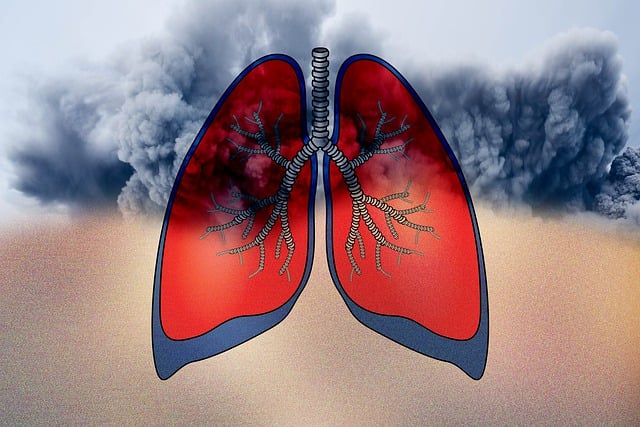Ultrasound and high-resolution lung CT (HRCT) are diagnostic tools for pleural effusion and lung abnormalities. While HRCT offers detailed imaging, ultrasound is a safer, accessible, and cost-effective first-line tool, ideal for initial evaluations, dynamic assessment, and guiding procedures like needle aspiration, especially in limited healthcare resources settings or when repeated imaging is needed.
“Uncovering hidden truths within the chest: Ultrasound as a powerful tool for diagnosing pleural effusion and lung abnormalities. While high-resolution lung CT is a go-to imaging method, ultrasound offers a non-invasive, cost-effective alternative with unique benefits. This article delves into the understanding of these conditions, exploring how ultrasound can accurately detect and differentiate pleural effusions from various lung pathologies. We weigh its advantages over HRCT, highlighting clinical applications and interpretation techniques to enhance diagnostic precision.”
Understanding Pleural Effusion and Lung Abnormalities
Pleural effusion refers to the abnormal accumulation of fluid around the lungs, within the pleural cavity. This condition can be caused by various factors, including pneumonia, heart failure, or cancer. When left untreated, it can lead to respiratory distress and impaired lung function. Lung abnormalities, on the other hand, encompass a range of conditions affecting the structure and function of the lungs, such as nodules, masses, consolidations, or interstitial changes.
High-resolution lung CT (HRCT) is a crucial imaging tool for diagnosing and evaluating both pleural effusion and lung abnormalities. It provides detailed, high-contrast images of the lungs, enabling radiologists to identify subtle changes in lung texture, detect small nodules or consolidations, and assess the extent of fluid accumulation around the lungs. This non-invasive technique offers valuable insights that aid in forming accurate diagnostic and treatment plans for patients presenting with these conditions.
Role of Ultrasound in Diagnosis
Ultrasound plays a pivotal role in diagnosing pleural effusion and lung abnormalities, often serving as a first-line imaging modality due to its accessibility, cost-effectiveness, and real-time capabilities. Unlike high-resolution lung CT (HRCT), which provides detailed cross-sectional images, ultrasound offers a dynamic view of the chest cavity, making it highly useful for detecting and assessing pleural fluid accumulation.
The skilled sonographer can identify effusions, their size, and location, as well as detect associated compressive effects on the lungs. Additionally, ultrasound can guide biopsy procedures for definitive diagnosis when needed. While HRCT remains crucial for comprehensive lung parenchyma evaluation, ultrasound serves as an indispensable tool in the initial assessment and management of pleural effusion and related lung pathologies.
Advantages Over High-Resolution Lung CT
Ultrasound offers several advantages over high-resolution lung CT, especially in certain clinical settings. One key benefit is its non-ionizing nature, making it a safer alternative for repeated imaging and pregnant patients. Unlike CT, ultrasound does not expose individuals to radiation, reducing potential long-term health risks. This makes ultrasound particularly appealing for longitudinal monitoring or in situations where multiple imaging studies are required.
Additionally, ultrasound provides real-time visual feedback, allowing for dynamic assessment of pleural effusions and lung abnormalities. It can easily detect changes in fluid levels and the presence of air bronchograms, enabling prompt clinical decision-making. Moreover, ultrasound is generally more accessible and cost-effective than CT scanners, making it a convenient choice for initial screening or in areas with limited healthcare resources.
Clinical Applications and Interpretation
Ultrasound is a valuable tool for evaluating pleural effusions and lung abnormalities, offering several clinical applications. It provides quick, non-invasive imaging, making it ideal for initial assessments and guiding procedures like needle aspiration. In cases where high-resolution lung CT (HRCT) may not be readily accessible or in situations requiring rapid evaluation, ultrasound excels at identifying effusion size, location, and any associated complications.
Interpretation involves examining the pleural space for abnormalities, such as fluid accumulation, thickening, or nodular structures. Lung abnormalities are assessed by evaluating lung texture, the presence of consolidations, and air bronchograms. The ability to visualize these features in real-time makes ultrasound a versatile tool for managing patients with suspected pulmonary issues, often serving as a bridge to more advanced imaging like HRCT when indicated.
Ultrasound has emerged as a valuable tool for assessing pleural effusion and lung abnormalities, offering advantages over traditional high-resolution lung CT. Its non-invasive nature, accessibility, and cost-effectiveness make it an ideal initial diagnostic choice. By quickly identifying and characterizing these conditions, ultrasound enables prompt clinical decision-making and targeted management strategies. While high-resolution lung CT remains crucial for detailed anatomical analysis, ultrasound provides a practical, real-time solution for many cases, ultimately improving patient care and outcomes.
